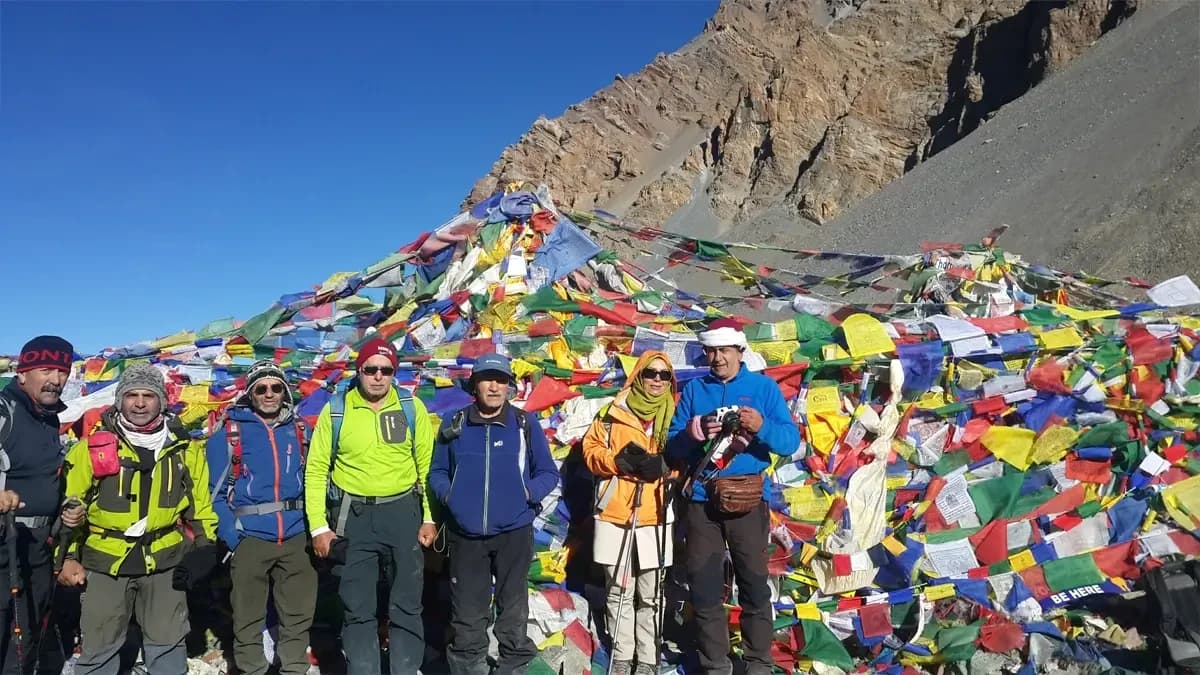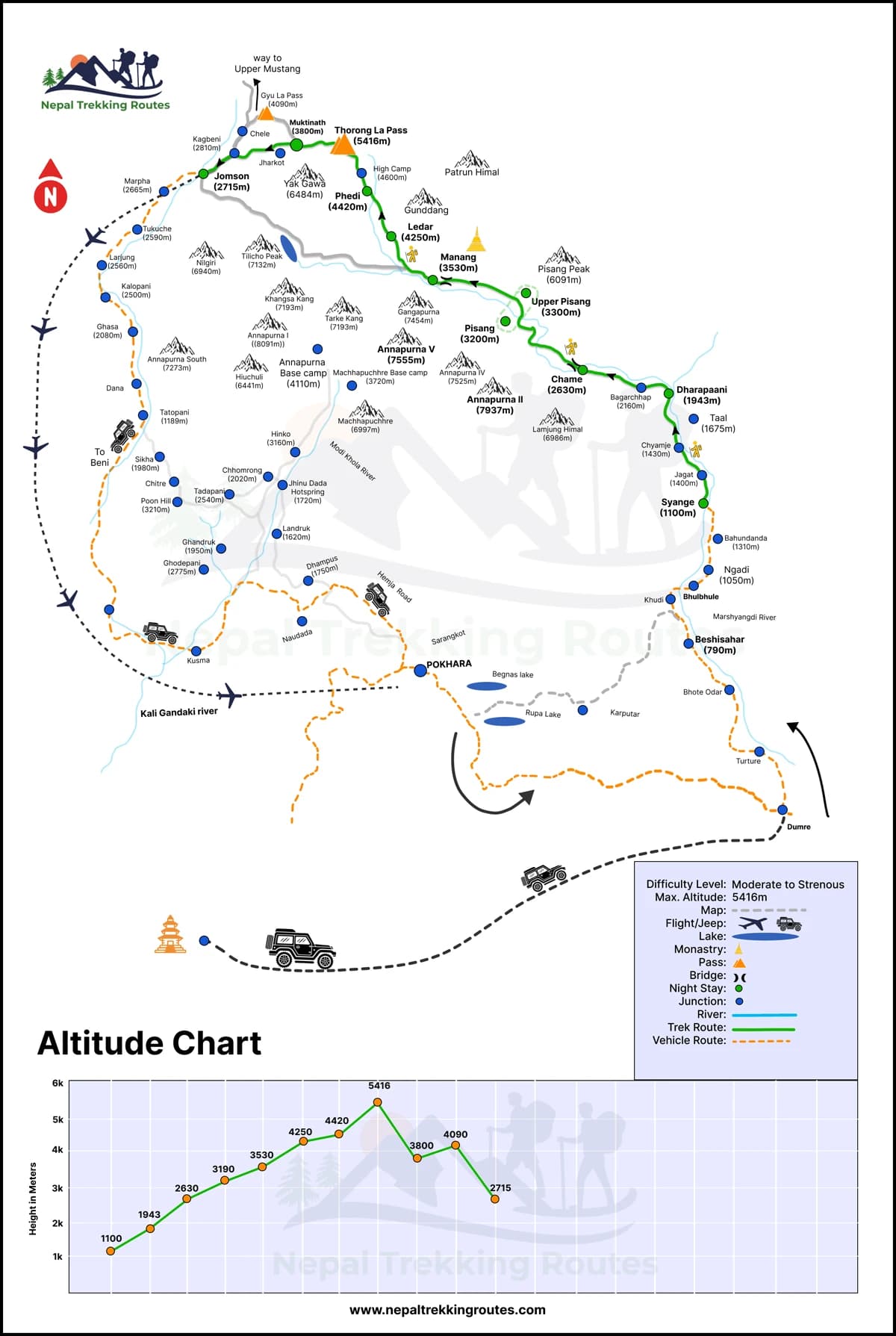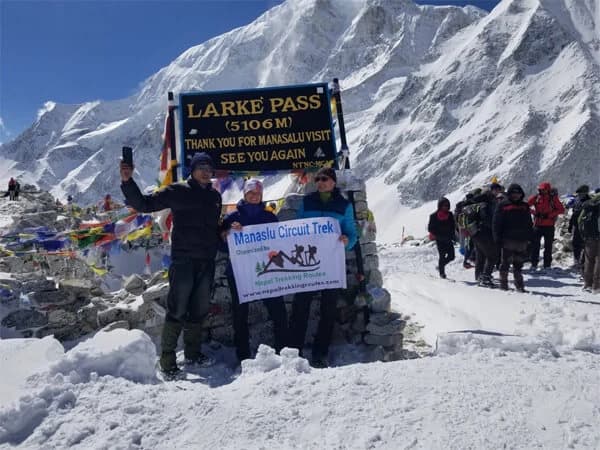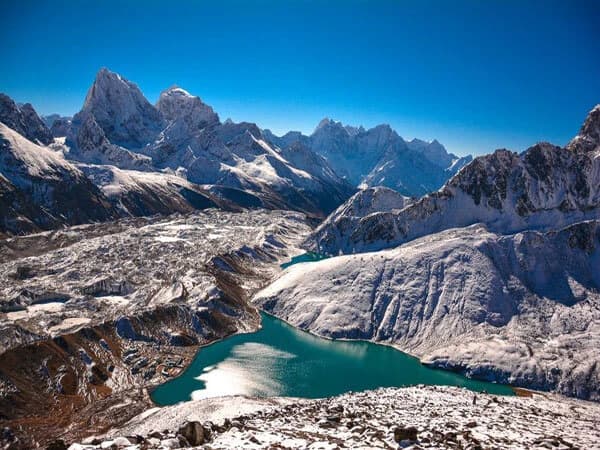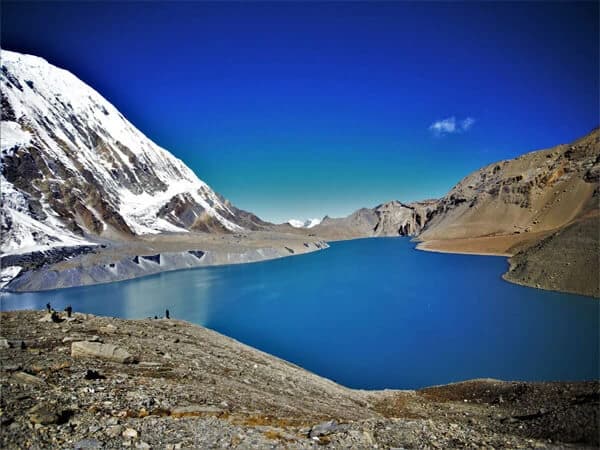Annapurna Circuit Trek Overview
Annapurna Circuit Trek through Manang and Mustang region is a fantastic adventure. The Mustang Region trek is rich in nature and culture. This is the most popular trekking region in Nepal. Many tourists prefer this Manang to Muktinath trek as an alternative to the Everest Base Camp Trek and Manaslu Circuit Trek. It has been estimated that nearly one-third of the trekkers coming to Nepal visit to do the Annapurna Round Trek.
Experience the wonderful combination of Himalayan views and amazing landscapes. This trek encircles the Annapurna Massif. Annapurna I (8,091 m) is the tenth-highest peak in the world.
The Annapurna Circuit Trekking trail is about 128 miles long. Enjoy the majestic views of the Dhaulagiri Massif, Tukuche Peak (6,920 m), Gangapurna Peak (7,454 m), and so on.
Round Annapurna Trekking rewards you with Himalayan views, unique lifestyle, culture, and tradition. The Gurung, Magar, Thakali, and other mixed communities have lived in this beautiful region since immemorial. This trek is also called Thorong La Pass Trek.
The ancient monasteries, mani walls, and chortens decorated with prayer flags are the ornaments of the Annapurna Circuit trek. Typical Thakali Cuisine has been an international brand of Nepali food. The uniqueness of this dish is that Nepali Daal Bhaat is served with the fermented green vegetable pickle it.
The trails of this trek run through the Annapurna Conservation Area Project (ACAP). A large variety of birds and animals are seen while walking along the pine, oak, fir, and rhododendron forests.
Muktinath Temple is another must-visit site during this trek. It is a popular pilgrimage site for both the Hindus and Buddhists. Every year, thousands of pilgrims from India and Nepal visit this shrine. The natural flame continuously burning with the help of natural gas is just amazing.
Major highlight of Annapurna Circuit Trek
- Exploration of the Marsyangdi River Valley,Manang Valley, and the Kali Gandaki River Valley
- Flora and fauna of Annapurna Conservation Area
- Thakali cuisine on the rest day in Manang Valley
- Crossing Thorung La Pass (5,416m)
- Snowcapped peaks of the Annapurna and Dhaulagiri Himalayan ranges
- Muktinath Temple is a commonplace of faith for both Hindus and Buddhists
- Scenic flight to Pokhara and exploration of the lake city
How to get Annapurna Trekking Routes?
Annapurna Circuit Trekking starts after visiting the UNESCO World Heritage Sites of Kathmandu. Then, it takes you around the Marsyangdi River Valley, Manang Valley, and Kali Gandaki Valley.
Walking along the quiet trails and enjoying the mountain peaks of the Northern Himalayas gives you a different experience of Nepal. The flora and fauna of Annapurna Conservation Area are the other alluring factors that attract national and international trekkers.
Formally, you begin the trek from Syange and then move ahead towards Dharapani, Chame, Pisang, and Manang. Pisang to Manang Trek offers two routes, the lower trail and the upper trail. After exploring the beautiful Manang Valley, you move further to Letdar and Thorung Phedi.
By crossing the highest place of this trek, Thorung La Phedi (5,416 m), you trek to Muktinath. You visit the Muktinath Temple and continue going towards Jomsom, the administrative headquarters of Mustang.
The next morning, you catch a flight to Pokhara in the morning or do the Jomsom to Pokhara trek. After reaching Pokhara, you can spend this day to visit the most tourist places of the Lake City Pokhara. Or you can drive to Kathmandu along the Prithvi Highway. Alternatively, you can also fly back to Kathmandu in about 25 minutes.
Annapurna Circuit Trek 15 Days Itinerary
The Annapurna Circuit Trek itinerary can be customized to fit any schedule, ranging from a one-day Annapurna Circuit Helicopter tour to a full 22-day trek. Nepal Trekking Routes offers a flexible 15-day Annapurna Circuit tour package, allowing you to tailor the journey to your preferences. If you have more time to explore, you can extend the trek or make additional adjustments to the itinerary to suit your interests.
Experience Our Annapurna Circuit Trek 15 days Itinerary a thrilling trekking adventure through diverse landscapes with Iconic Thorong La Pass Trek. Trekking through breathtaking Annapurna mountain views, himalayas vistas, rich culture and charming villages on the Nepal Annapurna adventure journey which is perfect for trekkers seeking a 15 days Annapurna Adventure with beauty and challenge.
There are various Annapurna circuit Trekking package base on the time for traveler. If you are looking for short Annapurna Circuit Trek, Annapurna circuit Trek 10 Days itinerary would be the best offer for you. Nepal Trekking Routes will provide the best itinerary for Annapurna circuit trek as per your interest. We are one of the best trekking companies for Annapurna Circuit.
Alternative Routes for Annapurna Circuit
Travelers can cut short the proposed itinerary or extend this to other regions as well. You can extend Annapurna Circuit Trek with Ghorepani Poon hill trek, Ghorepani Ghandruk trek, Annapurna Base Camp trek, Upper Mustang Trek, etc. You can even combine Annapurna Circuit Trek with Tilicho Lake for classic circuit trekking and visiting world's highest Lake. To customize the trekking packages, contact us via email, phone call, WhatsApp, or online booking system.
How much does it cost for Annapurna Circuit Trek?
The cost of a Nepal trekking package depends upon many factors like the duration, facilities you want, and the permits you need to buy. You can have an aerial view of Annapurna Circuit just in a couple of hours. For this, you have to go Annapurna Circuit Helicopter tour without landing.
The trek duration ranges from 1 day to 22 days. This means the cost of Annapurna Circuit Trek package for 1-day is different from that of 22 days. Likewise, from Jomsom, you can either fly to Pokhara or drive on a private jeep or local bus. A jeep ride to Manang is a scenic and convenient option to avoid time consuming and difficult trekking. So, the mode of transportation also plays a vital role in determining the cost of this trek.
There are basic to good hotels and lodges on the Annapurna Circuit Trek route. The cost of basic food and accommodation differs from that of quality services.
A private Annapurna Circuit Trek Tour includes personalized services, upgraded accommodations, and private transportation. Similarly, Luxury Annapurna Circuit Trek offers adventure and comfort with premium services, private transport and personalzed services. You can choose these options based on your budget.
You can fix the Annapurna Circuit Trek cost by consulting with Nepal Trekking Routes. We are one of the best trekking agency for trekking in Nepal. We are here to help you with Annapurna Circuit Trek budget plan according to your preferences. Therefore, contact us for the details either through email, phone calls, WhatsApp, or system booking services.
Is it possible to do solo Annapurna Round Trek?
There is no restricted area to include in this Annapurna trekking route, you can do the Annapurna Circuit trek without a guide. Doing Annapurna Circuit Trek solo is also possible as it is completely a teahouse trekking. The trails of this region are in good condition because they are frequently traversed by national and international trekkers.
But, we highly recommend you hire a professional trekking guide and a porter to cover the distance. As you have to go across a 5,416-meter pass, it is challenging as well. You may not be able to find the right and safe trekking trail as well.
If you hire a registered trekking guide, he will help you in case of altitude sickness and loss of the right trekking trail. More importantly, he gives you more details about the heritage sites you come across or see en route. Annapurna Region Trek guided tour is more safe and suitable for beginners.
For an organized Trekking in Annapurna Region, book via a local tour operator located in Kathmandu or Pokhara. Nepal Trekking Routes is the one having 100% success history records.

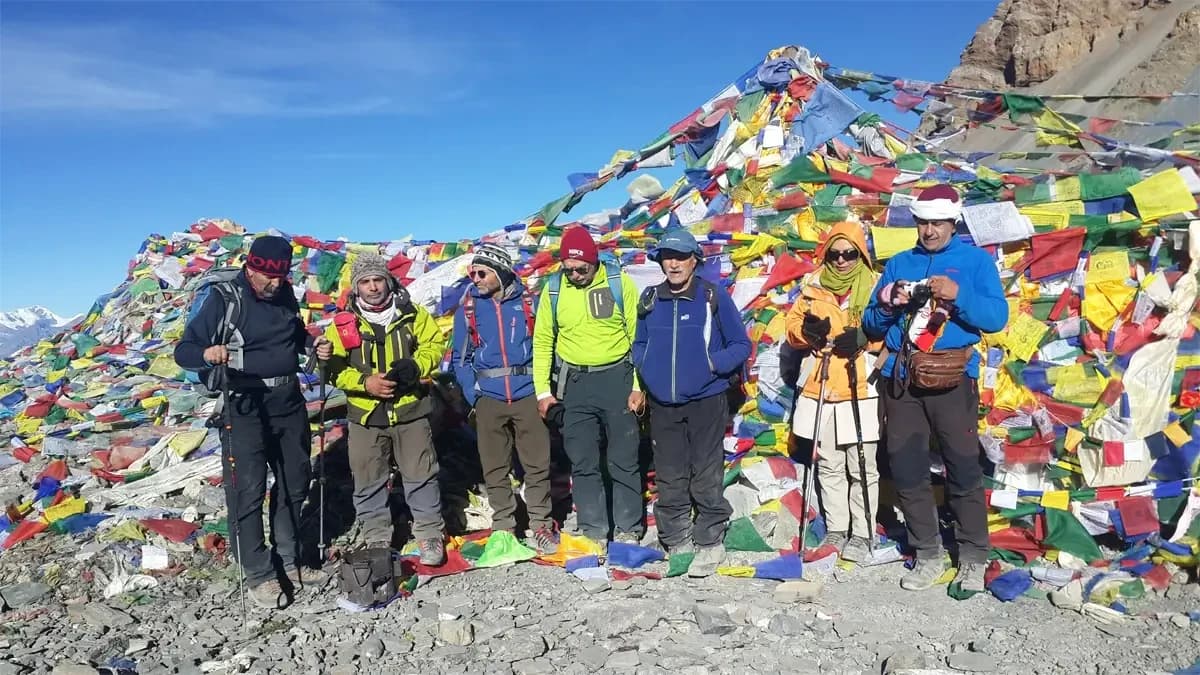
.webp&w=3840&q=75&dpl=dpl_4U3CaZUV3Y5iKdBNPJmVMATJy3AB)
